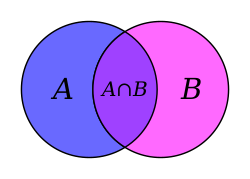Set theory - Simple English Wikipedia, the free encyclopedia

Set theory is the study of sets in mathematics. Sets are collections of objects. We refer to these objects as "elements" or "members" of the set. To write a set, one wraps the numbers in {curly brackets}, and separates them with commas. For example. the set holds 1, 2, and 3. Sets are also often referred to using capital roman letters such as , , .[1]
There are three methods one can use to describe a set: Description method, Roster method (tabular form) and Rule method (set builder form).
History
[change | change source]Set theory was created around 1874 by Georg Cantor.[2] It had to be made better because collections of objects can cause problems if we work with them without explaining them better. Russell's paradox was one of the problems. Think about the set of all sets that are not members of themselves. If it were inside itself, then the rule which defines it would mean that it is not inside itself. But, if it were not inside itself, then the rule which defines it would mean that it is inside itself. This was a serious problem, and it meant that the old set theory was broken. It was improved by people including Zermelo and Bertrand Russell.[3]
Theory
[change | change source]Set theory begins by giving some examples of things that are sets. Then it gives rules in which you can make other sets from the already known sets. Collections of objects that are not sets are called (proper) classes.[3] It is possible to do mathematics using only sets, rather than classes, so that the problems that classes cause in mathematics do not occur.
- Example: An object and a set . If is a member (or element) of , we write .[1] Since sets are objects, the membership relation can relate sets as well.
A binary relation between two sets is the subset relation, also called set inclusion. If all the members of set are also members of set , then is a subset of , marking . For example, is a subset of , but is not. From this example, it is clear that a set is a subset of itself. In cases where one wishes not to have this, the term proper subset is meant not to have this possibility.
The self-considering objects in set theory was considered too, with some example numbers being 1={1}, 2={1, 2}, 3={1, 2, 3} and so on.
Related pages
[change | change source]- Cantor set
- Cantor's theorem
- Cardinality
- Continuum (mathematics)
- Mathematical logic
- Naive set theory
- Zermelo–Fraenkel set theory
References
[change | change source]- ↑ 1.0 1.1 "Comprehensive List of Set Theory Symbols". Math Vault. 2020-04-11. Retrieved 2020-08-20.
- ↑ "set theory | Basics, Examples, & Formulas". Encyclopedia Britannica. Retrieved 2020-08-20.
- ↑ 3.0 3.1 Bagaria, Joan (2020). Zalta, Edward N. (ed.). The Stanford Encyclopedia of Philosophy (Spring 2020 ed.). Metaphysics Research Lab, Stanford University.
Further reading
[change | change source]- Chechulin V. L., Theory of sets with self-considering (foundations and some applications), Publishing by Perm State University (Russia), Perm, 2010, 100 p. ISBN 978-5-7944-1468-4 (In this non-predicative theory overcoming the limitations of predicative formal systems, i.e. Godel's theorems, the text is accessible from the page http://elibrary.ru/item.asp?id=15267103 )


 French
French Deutsch
Deutsch








